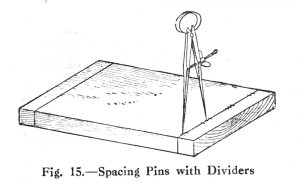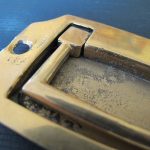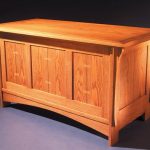We may receive a commission when you use our affiliate links. However, this does not impact our recommendations.
I’ve always been intrigued about the history of the way some English-trained woodworkers set out their dovetail joints using dividers.
I first learned to use this method – which I love – from Rob Cosman. He learned it from legendary craftsman Alan Peters. But where did Peters learn it from?
I don’t know, so I’m always on the lookout for early sources that cite this method.
This week I’ve been consuming “The Practical Woodworker,” which was edited by Bernard E. Jones. No, not the stinky piece of junk sold by Ten Speed Press. I’m talking about the original four-volume set from Waverly Book Co. in London.
It’s a sizable compendium of writings from a long list of experts that was edited into 1,500 pages of information on (mostly) hand-tool woodworking and published in the 1920s (well, that’s when my edition was published).
On page 227 is this great description of laying out pins-first dovetails.
While an expert worker will find the “sockets first” system most expeditious, it is perhaps not the best for the beginner, who will usually meet with less difficulty and fewer mishaps by adopting the “pins first” method, at any rate until some dexterity has been gained.
Here the boards are planed up and shot true at the ends, as before, and are gauged with a shoulder line all round at a distance equal to the thickness of the material. Next, on the shoulder line and at the outer side of the wood measure off at each end half the thickness of of the thinnest side of the pin. With the compasses or dividers divide the intervening space between these marks into as many parts, plus one, as there are to be whole pins (see Fig. 15), and on each side of these divisions mark off half the thickness of the pin, as shown.
Any slight inaccuracy at this stage will affect the appearance but not the fit of the dovetails.
This method is slightly different than Peter’s method. But they share the same fundamental idea: Step off your dovetails with dividers. The Jones method marks off the centerlines of the joint; Peter’s method marks off the extents.
So this 1920s method is close, but not exactly what I’m looking for.
— Christopher Schwarz
Want to learn more about this method?
Rob Cosman covers it in his DVD “Hand-cut Dovetails 2.0.” You also can learn more about it by watching the DVD “The Alan Peters Approach.” Both are available through ShopWoodworking.com.
Here are some supplies and tools we find essential in our everyday work around the shop. We may receive a commission from sales referred by our links; however, we have carefully selected these products for their usefulness and quality.











Chris, where did you purchase your dividers? Any particular thing I should be looking for?
Chris
Pardon my ignorance, what is the issue with Ten Speed Press’s version of The Practical Woodworker? Are they missing important informtion or…? I am new to the hand tool woodworking scene and just want to get the best and most accurate information that I can.
Thanks for your consideration
Laurence
Hi Chris, I have always wanted to know how to mark out dovetail spacings using dividers but have never been able to work out how it was done. Do I measure the distance between the end tails, divide that by the number of tails plus one, set my dividers to that figure and step away? This seems to be quite complex. Please tell.
Regards, Bernard Naish
Chris,
“The Practical Woodworker”, in its original four volume form, is a great reference work and I’m glad you’re finding it useful. The photographs and illustrations are first rate, the text is pretty straightforward, and it covers a broad range of subjects. Editing it down to a third of its original content was rather a shame on the part of Tenspeed Press.
I seem to remember hearing Alan say that he learned it as a boy, playing around with dividers. I think it was on the DVD “The Alan Peters Approach”, where Rob Cosman interviews Peters.
I would be very surprised if it didn’t go much farther back, to the Renaissance or even classical era. Geometry has been pretty sophisticated since at least Euclid, and the dividers were old enough and fundamental enough to make it onto the Masonic emblem (King Solomon’s dovetails?).
Documenting that would be another matter. If only there were a fiendishly curious, deeply read woodworking writer somewhere with an itch to search out old ways of working and their historic roots…
For a portrait of Douglas Cockerell with his dividers see http://www.clarksonconservation.com/zoom/profile_4.html
Wesley
Chris,
Hand bookbinders use this method to step off the sewing stations on the spines of books before sewing in exactly the same way as this. In the early days of the Arts and Crafts movement most of this small community knew each other. The bookbinder and printer T.J. Cobden-Sanderson (who coined the phrase “arts and crafts”) would have known this method from his teacher Roger de Coverly and passed it on to binders Sarah Prideaux and Katherine Adams. Adams lived in the Cotswold village of Broadway not far from Sapperton where Gimson and the Barnsley’s lived. Another connection would have been Emery Walker, a partner of Cobden-Sanderson and a friend of Gimson’s, who also lived in Sapperton and had Adams bind many of his books. Or it may have come from David Powell, who was at Edward Bansley’s shop at the same period as Alan Peters. Powell’s father was the bookbinder Roger Powell, for whom Sidney Barnsley made a bedroom set. The elder Powell studied with Douglas Cockerell, who had been in Cobden-Sanderson’s workshop as well.
Wesley
stinky piece of junk sold by Ten Speed Press
I have a Ten Speed Press “The Complete Woodworker” by Bernard E. Jones (1980) and I have to agree, not about the junk but about the unique smell. I imagined it was added later on to hide a mold odor.
Hello Chris,
You probably know this, but just in case you do not:
Alan Peters was born, January 1933, in Petersfield, Hampshire, England.
He was directly linked with the Arts and Crafts movement, as he had apprenticed to Edward Barnsley in 1949, until he left the Barnsley workshop in 1955.
Edward Barnsley’s father, (1900-1987), Sidney, his uncle Ernest and their friend Ernest Gimson, moved 1893, from London, to the Cotswolds to put their beliefs in what later became the Arts and Crafts movement into practice. This is the most likely source of the dividers technique.
Hope it helps
David
Hi. I just wantd to say, I use dividers method since Í learnt it from D Charlesworth, he mention R Cosman and both of them pick it up from A Peters who I believe learnt it from Barsley school.
Recently I´v finished a project including dovetails, inlaid dovetails angled, and I wanted to film some steps of the proccess. I´d wish you to have a look here, enjoy it !
http://www.youtube.com/watch?v=7reKGzKcv_w&list=UUOYoMnpXib6MuVCbNZdNs_w&index=1&feature=plcp
Hi Chris
perhaps a little video, where you demonstrate the trick, as you did in Metten. I have used the method ever since. I know its not exactly the topic of this blog post, but nevertheless, it is still worth showing.
Brgd
Jonas